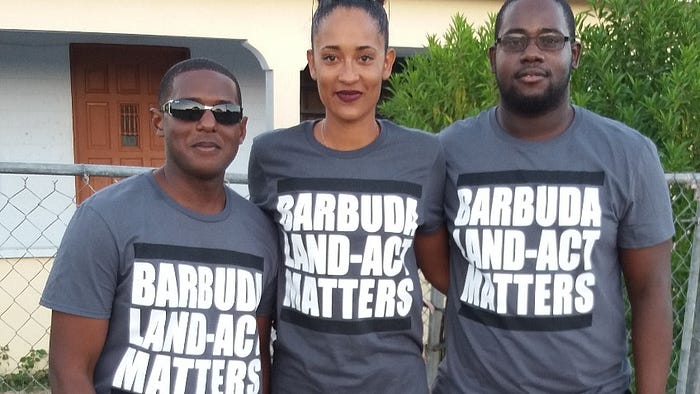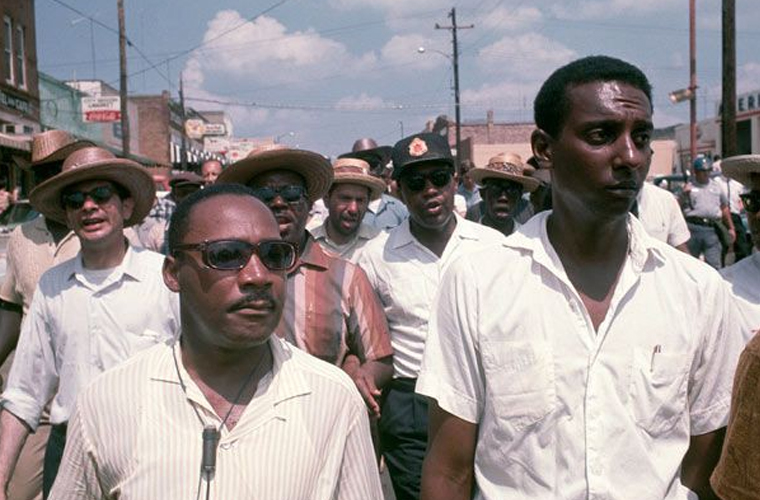When Prime Minister Maurice Bishop of Grenada was invited to the United States to give a speech at the Sixth Annual Dinner of TransAfrica, Bishop stated:
The links between our people and the 30 million Black people of America go far back into the chronicles of the European assault on our ancestral land and our common struggle against racist oppression and the enforced transportation of our ancestors to the Americas.
Indeed, African Americans and Caribbean people do share the bond of being descendants of people who were ripped from the African continent and enslaved in the Americas, but our historical links run even deeper than this, as Bishop himself explained:
Your history and ours have at times been so closely intertwined as to be nearly inseparable. We can point to Caribbean-American figures such as Marcus Garvey, for while he was born in the Caribbean, he has spent many of his more productive years living and working in the USA. By the same token, our Harry Belafonte is also your Harry Belafonte. Many, many eminent and distinguished black Americans are Caribbean-born or of Caribbean parentage. We point to a few examples such as Malcolm X and Sidney Poitier, Kwame Toure (formerly known as Stokely Carmichael), and Cicely Tyson. In fact, in the case of Malcolm, his mother came from a small village in Grenada, called La Digue. It is certain that some of you here tonight also share this distinction of Caribbean-American heritage.
The history of African Americans and Caribbean people is in fact a history that is so intertwined that it cannot be separated. As is so often the case when I write articles on Medium, I try to be as brief and concise as I can be because I am writing on topics that cannot be so easily summed up in a short article, so this article is by no means a complete view of the historical ties between African Americans and Caribbean people.
I begin during slavery. The Caribbean struggle against slavery and the African American struggle against slavery were interconnected in a number of ways. In the first place, it is necessary to understand the traffic of enslaved Africans did not only flow from Africa to the Western hemisphere. Enslaved Africans were also moved between the Caribbean and North America. In some cases, slave ships stopped in the Caribbean and it was from the Caribbean islands that some were sold to North America. I offer the specific example of Abdul Rahman Ibrahima Sori, an African prince who was captured and taken to Dominica. From there he was sold to a plantation in North America.
Denmark Vesey was born in St. Thomas. He was eventually brought to North America, where he gained his freedom. Denmark Vesey is best remembered for plotting a massive slave uprising, which was exposed before it could be carried out. Many enslaved Africans from Barbados also came to South Carolina. Keith Baird was a linguist from Barbados who once went on a trip to South Carolina. He was able to carry on a conversation with a Gullah woman. He spoke Bajan Creole and she spoke Gullah, but the two Creole languages are so similar that the two understood each other and were able to converse. A little-known fact about the American Revolution is that Haitian soldiers fought in that war. These troops were known as the “Chasseurs Volontaires.”
The migration went the opposite way as well. Many African Americans ended up in the Caribbean. Not only was there a connection between the Gullah people and Barbados, but there is a connection between the Gullah people and the Bahamas as well. Many enslaved Africans were taken to the Bahamas from North America. African Americans who fought for the British during the War of 1812, settled in Trinidad. These settlers became known as the Merikins. Hazel Manning, a former first lady and government minister in Trinidad, is a descendant of the Merikins.
For other African Americans, the Caribbean offered a freedom that America could not provide. Madison Washington led a rebellion onboard a slave ship and then sailed that ship to the Bahamas where slavery was already abolished. He spent the rest of his life there as a freedman. There were also African Americans who settled in Haiti after the Haitian Revolution. The most well-known example of this was Rev. James Theodore Holly. Haiti itself encouraged Africans from the diaspora to go to Haiti. A clause in Haiti’s constitution stated that anyone with African ancestry, regardless of the place of origin, would be regarded as a Haitian citizen.
The Revolution in Haiti survived as a source of inspiration for many African Americans and terrified many slave owners. One Florida newspaper warned: “Shall we wait till the tragic scenes of Hayti are commenced, before we act, and act efficiently.” Among those who were inspired by Haiti’s revolt was Martin Delany, who is often regarded as the father of black nationalism. Delany named one of his children after Toussaint, the leader of Haiti’s Revolution. Delany was also inspired by Cuba’s struggle against slavery, as can be seen in his book Blake or Huts of America, which features a fictional character named Henry Blake. Blake is an Afro-Cuban who is enslaved in the United States. In the story, Blake is related to a poet named Placido. Placido in Delany’s novel is based on the real-life Afro-Cuban poet named Gabriel de la Concepción Valdés, who was popularly known as Placido.
Delany is also significant for the fact that he was among those who promoted a return back to Africa. Delany would explore West Africa (present-day Nigeria) in search of a settlement for African Americans. Delany was accompanied by Robert Campbell, a Jamaican. Yet another prominent Jamaican abolitionist was John Brown Russwurm who, like Campbell, ended up resettling in Africa where he spent the remainder of his life.
During the period of slavery, there were some Caribbean people in the United States who were very active opponents of slavery. After slavery was abolished, Caribbean immigrants would continue to play a significant role in the struggles of African Americans. In the speech quoted above, Bishop mentioned some of the more well-known examples such as Marcus Garvey, Kwame Ture, and Harry Belafonte — he also mentioned Malcolm X, whose mother was from Grenada. There are more examples. This includes the Puerto Rican, Arthur Schomburg. Schomburg was a co-founder of the Negro Society for Historical Research, along with an African American man named John E. Bruce.
The writer and political activist Hubert Henry Harrison was born in St. Croix. Roy Innis, who served as the National Chairman of the Congress of Racial Equality (CORE), was also from St. Croix. J.C. St. Clair Drake, who was from Barbados, was an active member of the Universal Negro Improvement Association (UNIA) in the United States. Drake’s son St. Clair Drake became a prominent sociologist and anthropologist, as well as an advocate of Pan-Africanism. Shirley Chisholm is remembered for her historic presidential campaign. Shirley Chisholm’s parents were from Barbados and Guyana. W.E.B. Du Bois’ father was born in Haiti.
George M. James was the author of Stolen Legacy, which helped to lay the foundation for Afrocentric scholarship and challenged the Eurocentric approach to history. James was from Guyana. Yosef Ben-Jochannan and Ivan Van Sertima were two very prominent scholars who also contributed to shifting historical scholarship away from Eurocentrism and adopting a more African-centered approach. Van Sertima was also from Guyana and Dr. Ben’s mother was Puerto Rican.
The revolution in Grenada, which Bishop led, was also an event that influenced African Americans. In Nobody’s Backyard, Tony Martin compiled articles from Grenadian news sources during the revolution. The second volume of this work includes a chapter titled “Afro-America and Afro-Britain,” which contains articles on the influence that Grenada’s revolution had on African Americans. One member of a delegation that visited Grenada said:
Grenada is an inspiration to us. We need a victory every now and then, and this is definitely one. When more black people in the U.S. learn the truth about the process being built here and, even better, come to see for themselves, they will be strengthened in their own work and see what is possible more clearly.
There are more examples that I can give of Caribbean people making contributions to African Americans, but I will shift my focus a bit here to discuss how African Americans have influenced Caribbean movements. I will start with Marcus Garvey, who was inspired to found the UNIA after reading Booker T. Washington’s book, Up From Slavery. Garvey had made plans to visit Washington as well, but Washington died before Garvey could meet him. Washington’s ideas also influenced Jean Price-Mars, a scholar and politician from Haiti. Unlike Garvey, Price-Mars was able to personally meet with Washington. Price-Mars was also in contact with James Weldon Johnson. Johnson was among those African Americans who vocally protested America’s military occupation of Haiti from 1915 until 1934. Du Bois too protested the occupation of Haiti.
The Black Power movement in the United States significantly influenced the Caribbean as well, which is not surprising given that Caribbean activist were often in direct communication with African Americans. For example, in 1969 Pauulu Roosevelt Browne Kamarakafego organized a Black Power conference in Bermuda, which was attended by Queen Mother Moore and other American activists. Makandal Daaga, who was one of the leaders of the 1970 Black Power uprising in Trinidad, met with the New York branch of the Black Panther Party prior to the uprising in Trinidad— Trinidad would later develop its own branch of the Black Panther Party.
In Guyana, a Pan-African organization named the African Society for Cultural Relations with Independent Africa (ASCRIA) has established ties with African American activists. ASCRIA first came to the attention of African American activists when ASCRIA protested at the American embassy in Guyana after they read that an African American man named Ahmed Evans was sentenced to death by an all-white jury. ASCRIA was co-founded by Eusi Kwayana. Kwayana was married to an African American woman named Tchaiko. The two worked together on organizing the Sixth Pan-African Conference in Tanzania. Eusi worked with the delegate from the Caribbean and Tchaiko organized the delegates from America.
Political and social movements which began among African Americans have also found their way into the Caribbean. The Black Panther Party was mentioned as an example. There is also the Nation of Islam, which has branches throughout the Caribbean. The Black Lives Matter slogan has also inspired the people of Barbuda, who created the Barbuda Land Act Matters slogan to represent their struggle to retain communal possession of their land.

As I said, this is a very brief overview of the historical connection between African Americans and Caribbean people. As Maurice Bishop explained, our struggles and experiences have been so interconnected that we are in a sense inseparable. One cannot speak of the African American struggle for freedom without speaking of the role that certain Caribbean people have played and one cannot speak of the Caribbean’s struggle for freedom without acknowledging how African Americans have influenced Caribbean people in their struggles.
Dwayne is the author of several books on the history and experiences of African people, both on the continent and in the diaspora. His books are available through Amazon. You can also follow Dwayne on Facebook and Twitter.

